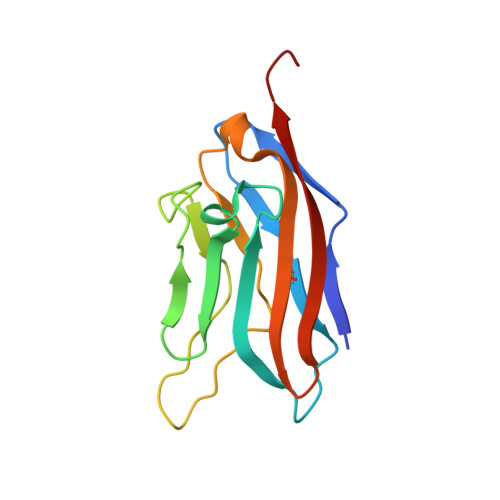Structure-guided engineering of CD112 receptor variants for optimized immunotherapy.
Singh, S., Julia, E., Kalita, P., Mason, C., Ming, Q., Lee-Sam, A., Gordon, S., Buitrago, M.E., Leung, D.W., Hwu, P., Luca, V.C.(2025) Mol Ther 33: 3590-3604
- PubMed: 40285356
- DOI: https://doi.org/10.1016/j.ymthe.2025.04.032
- Primary Citation of Related Structures:
9E6Y - PubMed Abstract:
The immune checkpoint protein, CD112 receptor (CD112R, also known as PVRIG), suppresses T and NK cell activation upon binding to tumor-expressed CD112 (Nectin-2) ligands. Here, we determine the structure of the CD112-CD112R complex and use it to guide the engineering of multiple CD112-targeting immunotherapy candidates. The 2.2 Å-resolution crystal structure reveals an antiparallel, lock-and-key binding mode in which CD112R disrupts CD112 homodimerization. Structural analysis informed directed evolution campaigns focused on remodeling the CD112-CD112R interface, resulting in the isolation of CD112R mutants with greatly increased expression and CD112-binding affinity. The highest-affinity variant, CD112R IVE , potently inhibits CD112-CD112R interactions when utilized as a soluble CD112 trap. Furthermore, incorporating CD112R variants into chimeric antigen receptors (CARs) and T cell engagers (TCEs) leads to more robust T cell activation and killing of CD112 + triple-negative breast cancer (TNBC) cells compared to wild-type CD112R. This strategy demonstrates how structural insights can be leveraged to efficiently generate panels of "affinity-tuned" biologics for immunotherapy.
- Department of Immunology, H. Lee Moffitt Cancer Center and Research Institute, Tampa, FL, 33612, USA; Cancer Biology Ph.D. Program, University of South Florida, Tampa, FL 33612, USA.
Organizational Affiliation:



















